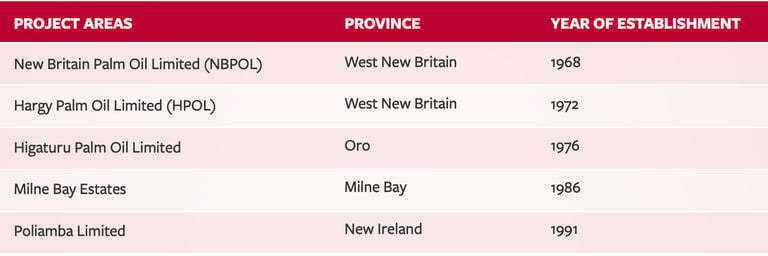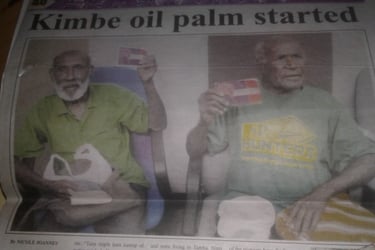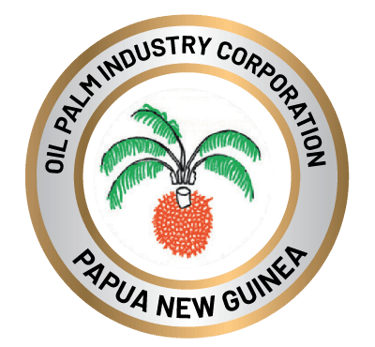HISTORICAL BACKGROUND
Oil palm was first introduced by the Germans in PNG in the 1890s. Commercial cultivation began in the late 1960s with the establishment of five (5) oil palm plantations, recognized under the Oil Palm Industry Corporation Act 1992 as Project Areas. The Project Areas are set out in Table 1 below.


The first oil palm project was established in Hoskins, West New Britain Province in 1968 as a public- private undertaking/arrangement. It was later known as the New Britain Palm Oil Limited (NBPOL). Following the establishment of the oil palm project in Hoskins, other oil palm projects were established in Bialla, Popondetta, Milne Bay and New Ireland as shown in Table 1 above.
The oil palm plantations were set up as Nucleus Estates Schemes (NES). Under the NES, plantation companies owned both the oil palm plantations and the crude palm oil mill. The surrounding areas around the companies plantations were allocated to smallholders who grew their own oil palm to supply Fresh Fruit Bunch (FFB) to the mills for processing and export of crude palm oil (CPO).
The Oil Palm Industry Corporation (OPIC) is a government agency that was established in 1992 through the enactment of the Oil Palm Industry Corporation Act 1992. Its primary function is to provide extension services to oil palm smallholders and out-growers in Declared Oil Palm Project Areas under the Oil Palm Industry.
Corporation Act 1992. Extension services include planting, replanting, harvesting, nurseries, pest and disease control, and plantation management.
It is important to note that OPIC does not regulate the oil palm industry. As such, the oil palm industry has never been regulated since the first commercial cultivation of oil palm in 1967 and continues to be unregulated to date. OPIC has been providing extension services to smallholder growers, and more recently, it has played a key role in providing efficient delivery programs and develop market infrastructure for the smallholders and out-growers. It has established operational sites in the declared project areas that are currently operated by NBPOL and HPOL.
However, OPIC has faced a lot of challenges over the years affecting the delivery Of its core responsibilities. The Oil Palm Industry Corporation Act 1992 limits the mandate of OPIC to extension services only and does not allow OPIC to regulate the oil palm industry. The Various agreements and laws for the different oil palm projects hinder or limit OPIC’s performance of its functions.
THE OIL PALM INDUSTRY CORPORATION
Oil Palm Timeline in PNG
1967
First commercial cultivation of oil palm in Hoskins, WNB in 1967
The first commercial oil palm project in Papua New Guinea was at Hoskins, West New Britain, in 1967, as part of Australia's economic development efforts to establish large-scale agriculture, beginning with smallholder farms under the Land Settlement Scheme (LSS). The Hoskins scheme was so successful that it led to the creation of two more oil palm schemes at Bialla and Popondetta shortly after.
1970
The International Development Association (I.D.A) Agreements 1970
1972
The Bialla Oil Palm Project, located in the West New Britain Province of Papua New Guinea, was established in 1972 as part of a nucleus estate model. This model involved a central estate that processed smallholder fruit and provided seedlings and services to surrounding settlers who leased small plots of land. The project has since grown significantly, with SIPEF (Hargy) commencing operations in 1978.
Bialla Oil Palm Project 1972
1976
Popondetta Oil Palm Project 1976
In 1976, the Papua New Guinea (PNG) government initiated the Popondetta Palm Oil Development Project through a joint venture with the British Commonwealth Development Corporation (CDC) to develop an oil palm estate-smallholder scheme, receiving a significant loan from the World Bank to fund the project. This initiative, also known as the Popondetta Oil Palm project, involved converting existing cocoa land into oil palm plantations and established the nucleus estate, which would serve as a source for planting material for smallholder farmers.
1985
Milne Bay Oil Palm Project 1985
The Milne Bay Oil Palm Project in Papua New Guinea was a development initiative designed to increase export earnings and develop the Milne Bay Province through the establishment of oil palm plantations, cocoa plantations, and smallholder blocks, supported by World Bank funding and a nucleus estate model. Launched by the mid-1980s, the project involved the construction of processing facilities and infrastructure, with the goal of creating a viable nucleus estate that would also benefit smallholder farmers in the region.
The Kavieng Oil Palm Project in Papua New Guinea was a development initiative designed to increase export earnings and develop the New Ireland Province through the establishment of oil palm plantations,
Kavieng Oil Palm Project 1991
1991
The IDA credit agreement was signed on January 30, 1970, and was part of a larger plan to finance agricultural development in Papua and New Guinea. The loan was intended to help develop agriculture through several projects, including:
Supporting smallholders in the expanding oil palm industry.
Expanding cattle breeding.
Developing coconut palms to maintain copra exports.
1992
Oil Palm Industry Corporation (OPIC) was established
The Oil Palm Industry Corporation (OPIC) is a government agency that was established in 1992 through the enactment of the Oil Palm Industry Corporation Act 1992. Its primary function is to provide extension services to oil palm smallholders and out-growers in Declared Oil Palm Project Areas under the Oil Palm Industry.


late Mr. Mais (white beard) and Mr. Numbasa. They flew them on the Australian Ansett plane from Wewak, East Sepik to Kimbe, West New Britain in late 1967. They were among the first oil palm growers to settle at Kapore LSS.
Oil Palm Industry Corporation
YFIG Ruma 1 Kennedy Estate, 7 Mile Port Moresby National Capital District.
Telephone: (675) 32O 1583/32O 1588 Facsimile: (675) 32O 1577
© 2025. All rights reserved. Oil Palm Industry Corporation, Port Moresby NCD.
Quick Links


Postal Address
P O Box 73, Port Moresby, National Capital District, Papua New Guinea
